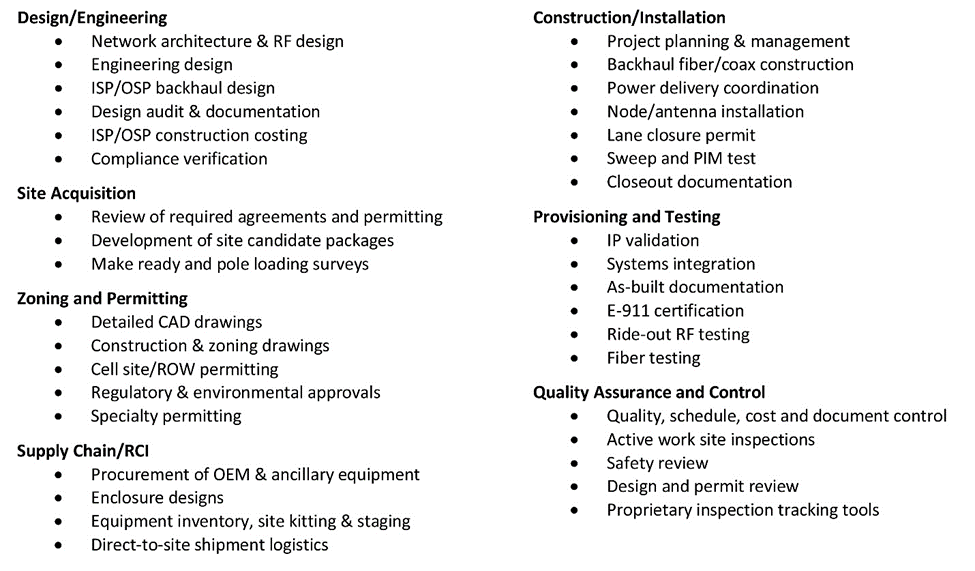
Citizens Band Radio Service (CBRS) has arrived and with it, 150 MHz of prime 3.5GHz spectrum in a low-cost shared spectrum model with few barriers to entry. Described by the FCC as “the innovation band”, CBRS LTE has attracted a variety of existing and new network operators. They include traditional small, medium and large service providers, as well as municipal public broadband operators, private enterprises and vertical markets such as utilities, education and transportation.
The initial view of CBRS 3.5GHz shared spectrum shows great potential for many exciting, new use-cases. While the opportunities are numerous and diverse this new ecosystem presents many operational challenges. For starters, planning, designing and deploying a CBRS LTE network involves more capabilities and resources than most organizations can provide.
What’s involved?
Companies ready to invest in owning and operating a CBRS LTE network already have a vision of what they want it to do. But the process of designing, engineering, building, provisioning, testing and ultimately turning up the network involves multiple layers of inter-dependent complexities. The following is a partial list of what’s involved:

The skills and experience needed for a company looking to own and operate a CBRS network present significant challenges. Designing the radio access network (RAN), for example, typically involves as many as half a dozen vendors or more—radio heads, baseband unit, outside plant, EPC, licensing, etc. And while LTE is a relatively mature technology, CBRS has attracted several new pure-play suppliers who must be engaged and vetted as well.
For non digital-native organizations, like public utilities and municipalities, the lack of technical expertise and vendor relationships create even more challenges. These organizations, however, typically realize that they do not have the technical chops and resources to pull off a CBRS network design/deployment project by themselves. It’s often the smaller and mid-sized service providers who are most likely to wade into a design/build project alone only to find that they have bitten off a bit more than they’re equipped to handle.
Third-party Services Integration (SI)
An alternative to the in-house approach is to outsource part or all of the project management to a third-party services integration partner. An experienced, well-equipped SI partner not only enables you to free up internal resources, they often have existing tools, processes and relationships that can accelerate the project and generate greater cost savings.
As with any outsourced relationship, finding the right fit is critical. At Fujitsu, we have completed hundreds of full and partial network SI management projects. Based on our experience, here are a few recommendations for finding and selecting an SI project partner.
- Vendor-neutral: This is key to ensuring you have access to the technology and services of all available vendors, not just those your SI partner works with. At the very least, if your partner does not have an active agreement with a potential vendor, they should commit to obtaining it.
- Needs-based a la carte services: The contracted scope of services should be dictated by your needs and in-house capabilities. The ability to pick and choose the services you need will deliver greater value and enable you to allocate internal resources as you see fit.
- Holistic release management: Any multi-vendor inter-operational solution involves a vast range of software and hardware components that must be integrated into the final product and managed going forward. A holistic release management approach ensures that any inter-operational conflicts are handled within the context of the entire project.
Ask, ask, ask
Finally, a good partner will work with you to define the project’s goals, scope, requirements and sequence. This means checking in repeatedly to make sure you understand what they are proposing and why. Don’t be afraid to ask questions. The process is complicated and the technology, complex; they may have been brought in for their technical and project management expertise, but you own and are ultimately responsible for your CBRS network. The more you know, the more successful it will be.
Headed to Mobile World Congress in Anaheim? Please visit Fujitsu in the CBRS Alliance OnGo Pavillion . We’d welcome the chance to speak with you about your plans for CBRS LTE integration. To learn more about what we offer, check out our Services Integration portfolio.